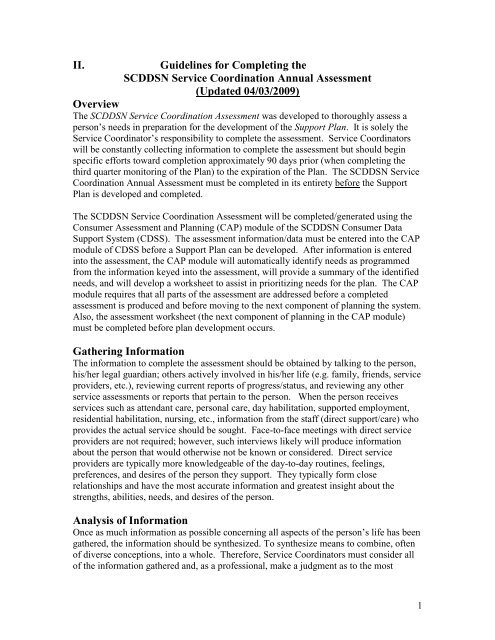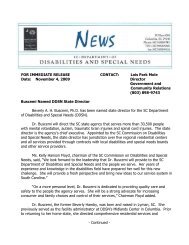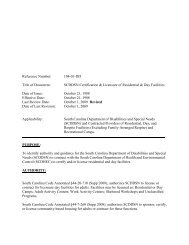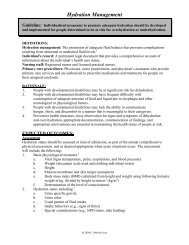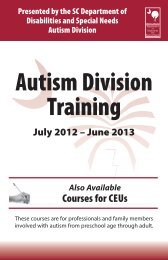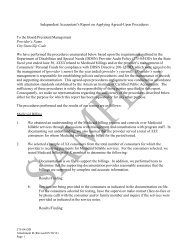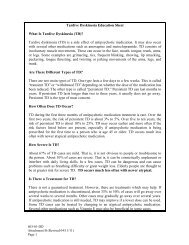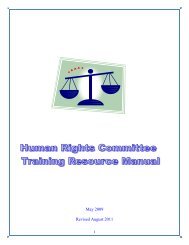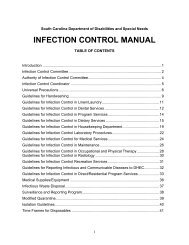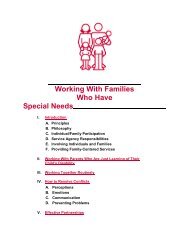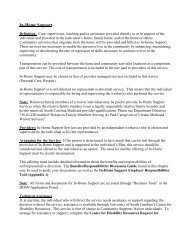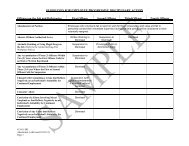II. Guidelines for Completing the SCDDSN Service Coordination ...
II. Guidelines for Completing the SCDDSN Service Coordination ...
II. Guidelines for Completing the SCDDSN Service Coordination ...
You also want an ePaper? Increase the reach of your titles
YUMPU automatically turns print PDFs into web optimized ePapers that Google loves.
SSDI (Social Security Disability Insurance): A cash benefit provided to disabled orblind people who are “insured” by workers’ contributions to <strong>the</strong> Social Security trustfund. These contributions are <strong>the</strong> Federal Insurance Contributions Act (FICA) socialsecurity tax paid on <strong>the</strong>ir earnings or those of <strong>the</strong>ir spouses or parents.SSI (Supplemental Security Income): Cash assistance payments to aged, blind, anddisabled people (including children under age 18) who have limited income andresources.VA Pension/Compensation (Veterans Affairs Pension/Compensation): Disabilitycompensation is a monetary benefit paid to veterans who are disabled by injury or diseaseincurred or aggravated during active military service. Veterans with low incomes whoare permanently and totally disabled may be eligible <strong>for</strong> monetary support through VA’spension program. Benefits may also be received by spouses, children and parents ofdeceased veterans.Disability Insurance: Disability insurance is insurance that can replace a portionof income when you a person is unable to work because of injury or illness. Thereare two major types of disability coverage: short term and long term. Short termdisability provides an income <strong>for</strong> <strong>the</strong> early part of a disability. Long termdisability helps replace income <strong>for</strong> an extended period of time, usually endingafter five years or when <strong>the</strong> disabled person turns 65.Workers’ Compensation: Workers' Compensation in South Carolina is a systemcreated and regulated by State law which requires most employers to obtaininsurance or to be responsibly self-insured <strong>for</strong> purposes of providing benefits toemployees injured at work. Benefits may include payment of medical bills, lostwages, and awards <strong>for</strong> permanent disability and scarring. (Workers'Compensation also covers treatment <strong>for</strong> occupational diseases if caused byconditions of employment). Dependants of employees who die as a result ofwork-related accidents or occupational diseases may be eligible <strong>for</strong> benefits.Food Stamps: The Food Stamp Program enables low-income families to buynutritious food with coupons and Electronic Benefits Transfer (EBT) card inauthorized retail food stores.Housing Supplement: A benefit to assist low-income people/families in having <strong>the</strong>opportunity to live in safe, decent, and af<strong>for</strong>dable housing. Refer to <strong>the</strong> State HousingAuthority website to find specific in<strong>for</strong>mation on <strong>the</strong> program/supplements available toSouth Carolinians (www.sha.sc.gov)Child Support: A cash payment made by <strong>the</strong> non-custodial parent to <strong>the</strong> custodial parent(who has physical custody) of a child <strong>for</strong> <strong>the</strong> purpose of assisting in supporting <strong>the</strong>financial needs of <strong>the</strong> child.Trust: A trust is a means by which an individual transfers legal ownership of funds to atrustee with <strong>the</strong> intention that <strong>the</strong> funds will be used by <strong>the</strong> trustee <strong>for</strong> <strong>the</strong> benefit of adesignated person.Health Insurance: Private health insurance is coverage by a health plan providedthrough an employer or union or purchased by an individual from a private healthinsurance company.5
or service in <strong>the</strong> local community), and <strong>the</strong> person paid <strong>the</strong> expense in a month that <strong>the</strong>yare or were working. Refer to www.socialsecurity.gov <strong>for</strong> fur<strong>the</strong>r in<strong>for</strong>mation pertainingto IRWE.Life Insurance/Burial Insurance: An insurance policy available upon death of <strong>the</strong> personto resolve expenses incurred by <strong>the</strong> person or needed to pay <strong>for</strong> burial expenses.Check all resources that apply in this section of <strong>the</strong> assessment by clicking on thoseitems.E. Activities/Skills/AbilitiesThis section is designed to broadly ascertain which daily living skills and personal care skills<strong>the</strong> person can do and/or those <strong>for</strong> which supports are needed. For each activity, indicate <strong>the</strong>amount of assistance needed, how often <strong>the</strong> activity is expected to occur, <strong>the</strong> frequency withwhich support is provided and <strong>the</strong> type of support provided. If supports are provided,indicate <strong>the</strong> ability of each supporter to continue and whe<strong>the</strong>r training, instruction orintervention would likely be beneficial and desirable. If it is not expected to be bothbeneficial and desired by <strong>the</strong> person, score “no”. Please Note: <strong>for</strong> some people, a supportmay be provided even though it is not needed (example: prepares meals with very little or nosupervision but support provided three times daily by paid supporter). Situations such as thisshould be explained in <strong>the</strong> comments section at <strong>the</strong> end of <strong>the</strong> section. Check all appropriateanswers <strong>for</strong> each question.I. Daily Living Activities/Skills/Abilities“Prepare meals” means prepare, not consume.“Housekeeping” includes tasks necessary to keep <strong>the</strong> home safe and clean includinglaundry, mopping, sweeping, general cleaning, trash disposal, etc.“Medical care/monitoring” are those skills of being able to take care of or arranging <strong>for</strong><strong>the</strong> care of and monitoring of medical conditions. This would be arranging <strong>for</strong> doctorsappointments, Home Health, basic first aid, treatment of colds or o<strong>the</strong>r common ailments;knowing when expert medical intervention is needed, etc.“Shopping” includes knowing what is needed, where to obtain, how to make purchases,etc.“Personal Finances” means being able to carry money to meet <strong>the</strong>ir financial obligations(such as paying bills, manage money, and purchase things <strong>the</strong>y need or desire; payincome tax).“Phone use” means making calls, receiving calls, phone etiquette, safety/calling 911 (notgiving personal in<strong>for</strong>mation to unknown callers), etc.<strong>II</strong>. Personal Care Activities/Skills/AbilitiesRespond as indicated.8
Eating means consuming food, not preparation of meal or clean-up after meals.“Taking or applying medication” means being able to remember when and how to take orapply medications as prescribed and being able to take/apply OTC medicationsappropriately.“Transferring” means being able to physically move self into and out of wheelchair fromo<strong>the</strong>r locations (i.e., bed, toilet, bathtub/shower, car, etc.).“Supervise self” is to be able to be alone, or to be without <strong>the</strong> supervision of ano<strong>the</strong>r, anddo so without threat of danger. The age of <strong>the</strong> person must be considered. Theexpectation is that no supports are needed if <strong>the</strong> needed supervision is equivalent to thatof someone of <strong>the</strong> same age who does not have a disability. If currently beingsupervised, this assessment must not automatically reflect <strong>the</strong> supervision provided. If anadult receives more supervision than appears to be needed, this should be noted andaddressed. Please note: For those enrolled in <strong>the</strong> MR/RD or HASCI Waiver under <strong>the</strong>ICF/MR Level of Care, section <strong>II</strong> of <strong>the</strong> Level of Care Determination should be consistentwith this response.Provide in<strong>for</strong>mation in this section (numbers 3- 6) about <strong>the</strong> person’s abilities related tomobility and access, fine motor, communication and basic transportation including anyequipment used to aid <strong>the</strong> person in <strong>the</strong>se areas.Note: For “Communication”, question 5 in this section, truly not communicating is rare.Many people communicate without words through expressions, gestures, behavior. If <strong>the</strong>person does not use words, it is important to determine how he/she does communicate. If<strong>the</strong> person truly does not communicate (e.g., chronic vegetative state, persistentvegetative state) <strong>the</strong>n note in <strong>the</strong> comments box at <strong>the</strong> end of this section.Note: For “Basic Transportation”, question 6a in this section, <strong>the</strong> availability of basictransportation implies that a vehicle is available.Check all appropriate answers <strong>for</strong> each question.F. Emotional, Mental, Behavioral Health:In this section, <strong>the</strong> intent is to identify any behaviors, mental health or emotional issues thatare a concern and <strong>the</strong> affect <strong>the</strong>se issues have on <strong>the</strong> person’s abilities so that consideration isa priority during planning. Behaviors or o<strong>the</strong>r issues that are historic (not occurringpresently) may still be considered. For example, incidents of criminal behavior may not beoccurring presently due to supervision; however, repeated historic incidents make this aconcern that must be considered when planning. This section also includes any services orsupports currently provided to address emotional, mental or behavioral health, whe<strong>the</strong>r <strong>the</strong>service/support is effective, and whe<strong>the</strong>r or not <strong>the</strong> person is satisfied with <strong>the</strong> service.Please note: Responses in this section should correspond to responses in section <strong>II</strong> of <strong>the</strong>ICF/MR Level of Care if <strong>the</strong> ICF/MR Level of Care is completed.Choose appropriate answers <strong>for</strong> each question.9
G. Educational Opportunities:This section is intended to identify if <strong>the</strong> person is interested in an educational program or ifattending school, <strong>the</strong> type of school and any concerns related to <strong>the</strong> person’s currenteducational program.Choose appropriate answers <strong>for</strong> each question.H. Vocational:This section is intended to identify <strong>the</strong> supports/services needed, if any, to enable <strong>the</strong> personto work or continue to work. “Competitive job” means working in a job making competitivewages; “sheltered work setting” means working <strong>for</strong> less than competitive wages withsupports in settings like <strong>the</strong> Adult Activity Center, Enclave, Mobile Work Crew, DDSN<strong>Service</strong> Provider owned business (if not paid competitive wage).Choose appropriate answers <strong>for</strong> each question.I. Living Environment:This section is intended to identify <strong>the</strong> person’s current living situation, <strong>the</strong> supports/servicesprovided in that setting, <strong>the</strong> status and stability of <strong>the</strong> situation and any related needs. Ofparticular importance is <strong>the</strong> assessment of how prepared <strong>the</strong> person is <strong>for</strong> emergencies, howlikely it is that this situation will continue, and how satisfied <strong>the</strong> person is with <strong>the</strong> currentsituation.Choose appropriate answers <strong>for</strong> each question.J. Community Connections:This section is intended to identify whe<strong>the</strong>r <strong>the</strong> person is present, participates, and/or has arole in <strong>the</strong>ir community.“Present” = is <strong>the</strong> person ever in <strong>the</strong> community; do <strong>the</strong>y accompany o<strong>the</strong>rs to <strong>the</strong> store,bank, church, etc.“Participates” = actually uses <strong>the</strong> community services first hand (makes own purchases, doesown banking, etc.).“Has a role” = holds some “position” in <strong>the</strong> community such as a regular customer/patron,church member, church usher or choir member. The person is considered to “have a role”when he/she is known in <strong>the</strong> community and his/her presence is expected.Choose appropriate answers <strong>for</strong> each question.K. Natural Support Network:This section is intended to identify if <strong>the</strong> person has contact with family and/or friends, and if<strong>the</strong>y are satisfied with <strong>the</strong> amount of contact <strong>the</strong>y have. Having family and friends oftenprovides one with a support network through which <strong>the</strong> person’s welfare is “monitored” and10
needs are met without a paid support. Family and friends may help <strong>the</strong> person with findingmonitored paid solutions to concerns.Choose appropriate answers <strong>for</strong> each question.L. Self-Advocacy and Rights:This section identifies whe<strong>the</strong>r <strong>the</strong> person expresses personal preferences and interests,makes <strong>the</strong>ir own choices, demonstrates problem-solving skills, advocates <strong>for</strong> <strong>the</strong>mselves,whe<strong>the</strong>r adjudicated incompetent and who <strong>the</strong>ir legal guardian is, whe<strong>the</strong>r <strong>the</strong>y know andexercise <strong>the</strong>ir civil and human rights, and whe<strong>the</strong>r <strong>the</strong> person feels <strong>the</strong>y are treated fairly. Include in<strong>for</strong>mation about basic civil and human rights. Provide in<strong>for</strong>mation about considerations to be made when <strong>the</strong> person doesn’t expresspreferences, exercise rights; give consent (consider DDSN Policy #535-07-DD,Obtaining Consent For Minors and Adults )Choose appropriate answers <strong>for</strong> each question.M. Personal Priorities:This section will identify if <strong>the</strong> person has chosen goals <strong>for</strong> his/her life and if he/she hasexpressed an interest in obtaining assistance to achieve those goals.Choose appropriate answers <strong>for</strong> each question.CDSS Consumer Assessment and Planning Module “Worksheet”When completed and an assessment completion date is entered, a summary of needs isautomatically generated by CDSS based on entered/chosen responses to each question. Thesummary of needs can be printed and serve as a tool <strong>for</strong> planning. Those items on <strong>the</strong>assessment that are indicative of a need (those with shaded boxes and o<strong>the</strong>rs as generated byCDSS and seen on <strong>the</strong> printed document) should be prioritized using <strong>the</strong> CDSS ConsumerAssessment and Planning Module “Worksheet”. Once needs are prioritized/grouped accordingto <strong>the</strong> service/intervention to address <strong>the</strong> need, <strong>the</strong> CDSS will generate a Support Plan. EveryWaiver service will have a separate need on <strong>the</strong> plan; <strong>the</strong>re<strong>for</strong>e, when completing <strong>the</strong> worksheet,make sure needs are not grouped toge<strong>the</strong>r if provided when addressing needs..11


